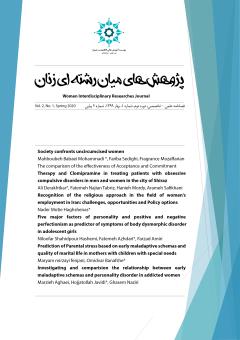Recognition of the religious approach in the field of women's employment in Iran: challenges, opportunities and Policy options
Subject Areas : Review and critique existing views on women and the family
1 - PhD in Demography, Assistant Professor, Department of Population Economics and Human Capital, Institute of Comprehensive and Specialized Population Studies and Management Country, Tehran, Iran
Keywords: Islam, Women's Employment, Opportunities and Policy Options,
Abstract :
Women's employment has always been discussed in various dimensions. The creation of paradox in the field of women's employment has raised questions among thinkers in the economic, social, moral, and religious spheres. The argument of this article is to see what is Islam's approach to women's employment? What are the obstacles and challenges facing the issue of women's employment in an Islamic society? This research has tried to analyze the economic and living conditions of women by documenting the systematic and exploratory study by reviewing the systematic studies conducted in this field and the theoretical considerations taken from the Islamic point of view, emphasizing its adaptation to the original religious teachings in Islamic Iran. Pay attention to the main purpose. The findings show that although Islam has given women the principle of economic independence, women are both the owners of their labor and production and have no responsibility for the family's economy, but in the context of handing over labor to women in Islam, the interests of society, the family It also takes into account individual circumstances and issues, which create limitations for women's work. Certificates of cognitive population show that women's economic participation has increased from 12.93 percent in the 1976 census to 16 percent in the 2016 census, indicating a change in the participation of women in the Islamic economy, a change in their personal and social identities. An increase in the number of female graduates, women’s employment in different economic sectors and increase in women's activity in management sectors compared to previous decades indicate a significant growth. However, the lack of equal opportunities in favor to men to find jobs, lower wages than men and the unemployment rate of women, especially in higher education, the existence of some social and cultural restrictions on women's employment, attitudes and misconceptions. Compared to the competence of women in various jobs, the expansion of gender inequality in access to resources and the consequent increase in harm due to the lack of readiness and recognition of society are the main concern and challenge of women's employment in the Islamic Republic of Iran.
1- ايران¬نژاد پاريزي، م.، و ساسان گهر، پ. (1375). سازمان و مديريت: از تئوري تا عمل، چاپ سوم. تهران: مؤسسه بانكداري ايران، بانك مركزي جمهوري اسلامي ايران.
2- الوانی، م. و ضرغامی¬فرد، م. (1380). نقش زنان در توسعه، تدبیر، 113.
3- بانکی¬پور¬فرد، ا. (1381). آیینه زن: مجموعه موضوعی سخنان مقام معظم رهبری، قم، کتاب طه.
4- بحرینی، م.، و العبدالخاني، س. (1394). جايگاه اشتغال زنان از نظر اسلام. پژوهش¬نامه اسلامي زنان و خانواده، 3(2)، 119-137.
5- برايسون، ج. (1369). فرآيند برنامهريزي استراتژيك براي سازمان¬هاي دولتي و غيرانتقاعي.ترجمه منوريان، ع.. جلد 10. تهران: مركز آموزش مديريت دولتي.
6- بيلو، پ.، آکامب، ب.، و موریسی، ج. (1376). راهنماي اجرايي برنامهريزي استراتژيك. ترجمه شريفي كلويي، م. تهران: دفتر مطالعات و برنامهريزي شهر تهران.
7- خمینی، ر. (1374). سیمای زن در کلام امام خمینی. تهران، وزارت فرهنگ و ارشاد اسلامی.
8- خمینی، ر. (1363). کلام امام. تهران، امیرکبیر.
9- خمینی، ر. (1378). صحیفه امام. مؤسسه تنظیم و نشر آثار امام خمینی، تهران.
10- زراءنـژاد، م.، و منتظـر حجـت، ا. (1384). نگـاهی بـه مشـارکت اقتصـادی زنـان در ایـران.
11- سازمان تأمین اجتماعی. (1397). آمار زنان تحت پوشش بیمه سازمان تأمین اجتماعی، تهران.
12- سلیمانی، م. (1390). اسلام و اشتغال زنان. پژوهش¬نامه اسلامی زنان و خانواده پژوهش¬گاه علوم انسانی و مطالعات فرهنگی، انتشارات طهورا، سال چهارم، شماره 8.
13- سرمد، ز.، بازرگان، ع.، و حجازی، ا. (1378). روش¬هاي تحقيق در علوم رفتاري، تهران: انتشارات آگاه. چاپ دوم.
14- کاظمی¬پور، ش. (1385). تحولات اخیر و آینده وضعیت اشتغال و بیکاری در ایران با تأکید بر وضعیت اشتغال زنان. نامه انجمن جمعیت¬شناسی ایران،1(1)، 20-42.
15- کمایی، م. (1387). تکامل کمی و کیفی مشارکت زنان در اقتصاد ایران، سرمايه، شماره 818؛
16- کریمی، ز. (1381). سهم زنان در بازارکار ایران. اطلاعات سیاسی - اقتصادی، 16(18-179)، 219-208.
17- کولایی، ا.، و حافظیان، م. (1385). نقش زنان در توسعه کشورهای اسلامی. پژوهش زنان، 4(1 و 2)، 33-60.
18- مرکز آمار ایران، (95-1335)، سرشماری عمومی نفوس و مسکن، تهران، انتشارات مرکز آمار ایران.
19- محمدی صیفار، م. (1385). مشارکت اجتماعی زنان از نظر حضرت امام خمینی، پگاه حوزه، شماره 182؛
20- مطیع حق¬شناس، ن. (1392). تأثیر تحولات ساختار جمعیتی بر عرضه نیروی انسانی و وضع فعالیت اقتصادی در ایران و آیندهنگری آن تا افق 404. فصل¬نامه مطالعات جمعیتی، 2، 89-116.
21- میرزایی، م.، و مطیع حق¬شناس، ن. (1397). عوامل مؤثر بر تمایل به تغییر شغلی دانش¬آموختگان آموزش عالی در ایران با تأکید بر ساختار سنی جمعیت، 94-1384. نامه انجمن جمعیت¬شناسی ایران، 24، 107-69.
22- مصطفوی، ف. ، شریعتی سبزواری، م.، و جعفری ورامینی، ف. (1393). زن از منظر اسلام، قم. انتشارات بوستان کتاب قم.
23- معاونت امور زنان و خانواده ریاست جمهوری، (1396)، معاونت بررسی¬های راهبردی، گزارش وضعیت زنان و خانواده در آیینه آمار طی سال¬هاي 95-1390، تهران.
24- نوروزي، ل. (1383 ). تفاوت¬هاي جنسيتي در ساختار شغلي. پژوهش زنان، 2(1)، 165-178.

